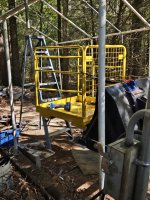I just skimmed through the video. Why did he build that scaffolding around the top of that tower?
I would only be guessing, but I would bet it is adding some compression to keep the top of the chimney together. Listening to him explain things on other videos, it is my perception that he has very good mechanical and practical insights gained from studying mining and steam engineering around him that took him down different paths to much of the accepted wisdom. I like the ladder video as he talks about why his method works and is safe, and practically how to get the work done as a solo operator.
One of his specialties for chimney removal (definitely a different method to the accepted wisdom) was to "burrow" into a chimney base, putting up wood mine props as he went. When he had about 10% of the base hollowed out, he would light a fire on the outside, and use the chimney to pull a strong draft. The fire burned up the supports, causing the chimney to tip over. He managed to drop the chimneys very accurately, within a few feet of the intended target. The film clips are pretty amazing.
The brick by brick removal for the chimney demolition above was done because there was a factory surrounding the chimney that still had staff working while the chimney was there, and no free space to drop the whole chimney. The pressure on the factory operators was that these were coal chimneys left over from the start of the Industrial Revolution and after 100-150 years the chimneys were losing their mechanical integrity. Watch how easily the bricks come apart in the film clips. There wasn't much more than inertia holding things together. The chimneys he dropped intact tend to fragment to a pile of bricks as they touch the ground. Now imagine being 200-300' on a pile of bricks playing Jinga.
They say that he was happiest repairing the chimneys and keeping them going.
All I know is that I have ways had a respect for heights and perhaps an overdeveloped sense of what a fall from even house roof could do to me. I would never have been safe doing what Fed did- I would have been too scared to think straight, much less work. I can't even imagine doing what
@not2old did on a 60' ladder.
All the best,
Peter

